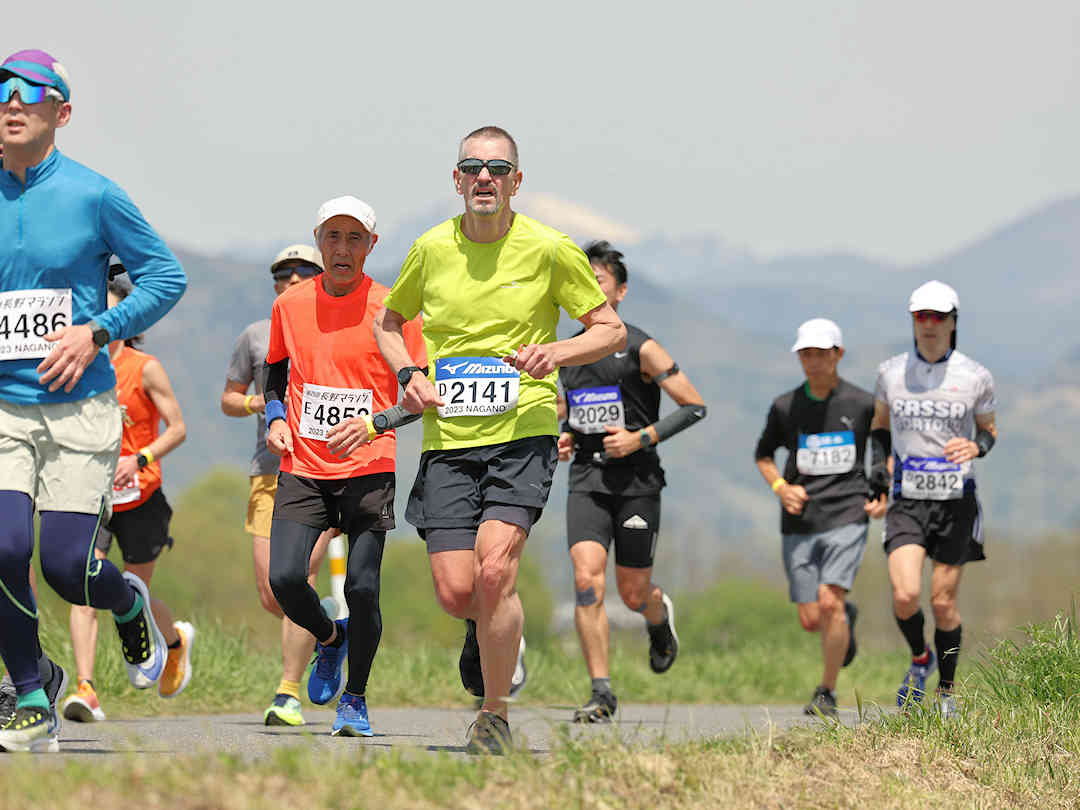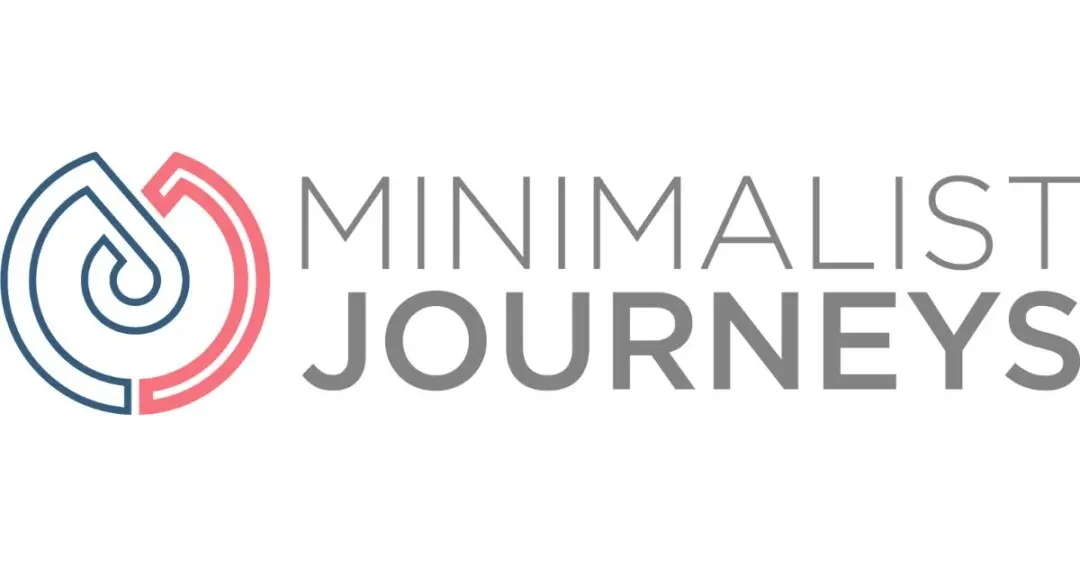This article may contain links to products and services we use and recommend. We may receive compensation when you click on links to those products. For more information, see our Disclosure Policy.
Would you like to run a marathon in Japan but don’t qualify for Tokyo and aren’t keen on joining the crowds in Osaka? Well, come to Nagano. Framed by the snow-capped Japanese Alps and with on-course entertainment that puts many majors to shame, the Nagano Marathon makes for a unique race experience. Sounds great? Lace up your running shoes, and let’s get you on your way.
Planning your trip to Nagano last minute?
You may also want to check out the accommodation bookable through Nagano Marathon partner JTB.
- Nagano Food Walking Tour
- Izakaya Food Night Tour
- Massage at Relaxation Salon Lovina
- 2-Day Zenkoji Overnight Tour with Shukubo Temple Lodging
We use and recommend Airalo eSIMs for affordable, hassle-free internet access in 200+ destinations. Activate before you arrive and get online instantly.
How did the Nagano Marathon come about?
The first marathon in Nagano was held in 1958. It was called the Shinmai Marathon, named after the local media outlet Shinano Mainichi Shimbun, which is shortened to Shinmai in Nagano Prefecture. Only attended by Japanese athletes, the Shinmai Marathon was held until 1998, when Nagano prefecture hosted the XVIII Winter Olympics.
In 1999, the marathon was renamed the Nagano Olympic Commemorative Marathon, a more suitable name as the course takes athletes past all the major Olympic venues in Nagano.
The marathon is sanctioned by the Japan Association of Athletics Federation (JAAF) and is a member of the Association of International Marathons and Distance Races (AIMS). It was a World Athletics Bronze Label Road Race competition, but doesn’t appear to have retained its World Athletics label post-COVID.
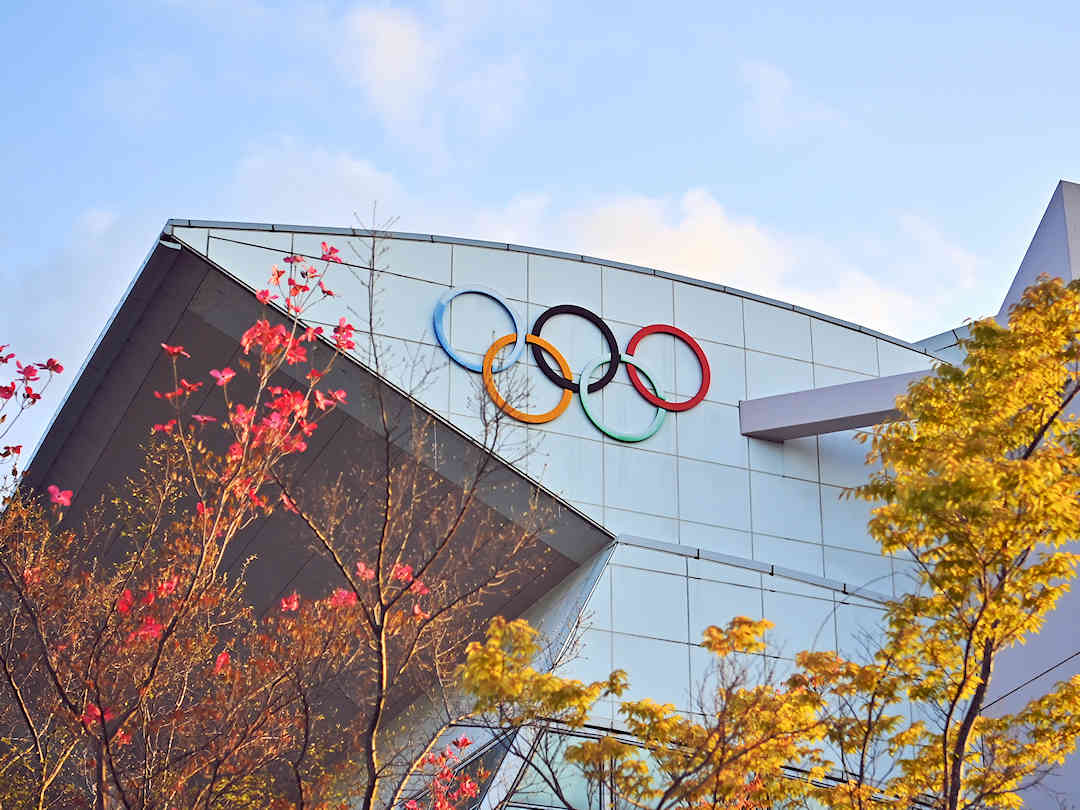
The Nagano Marathon takes athletes past major Winter Olympics venues in the city of Nagano | Photo by All Sports Community
When is the next Nagano Marathon scheduled to be held?
The 2026 Nagano Marathon is scheduled for Sunday, 19 April 2026. Held in the second half of April, there is a high chance of seeing cherry trees bloom during the race while the surrounding mountains are still covered in snow, adding to the unique atmosphere of the race.
What is the weather like during the Nagano Marathon?
Race day in 2025 was consistently overcast, offering some relief from direct sunlight. However, participants still faced steadily rising temperatures and moderate humidity, which created a subtle but cumulative physical challenge, particularly for those finishing later in the day.
Start (8:00 AM, Nagano Observatory)
Cloudy, 16.4°C, 72% humidity, light breeze from the south-southeast at 0.6 m/s.
By 10:00 AM
The temperature rose to 19.3°C, with humidity easing to 63%. Winds remained light, shifting from the east at 2.2 m/s.
Mid-Race Finish Times (~10:43–11:03 AM, Minami Nagano)
Temperatures reached 20.0–21.0°c with decreasing humidity, as low as 52%. The wind varied slightly between southwest and west-southwest directions, with mild speeds ranging from 0.9 to 1.3 m/s.
Afternoon Conditions (12:00–1:20 PM)
Temperatures peaked at 23.6°C, humidity dropped to 49%, and wind speeds increased to 5.4 m/s from the east.
While there was no rainfall, the warmer late-morning temperatures and increasing wind, especially from midday onward, made hydration and pacing more critical than usual. Future runners should be prepared for gradual temperature changes, even with cloud cover.
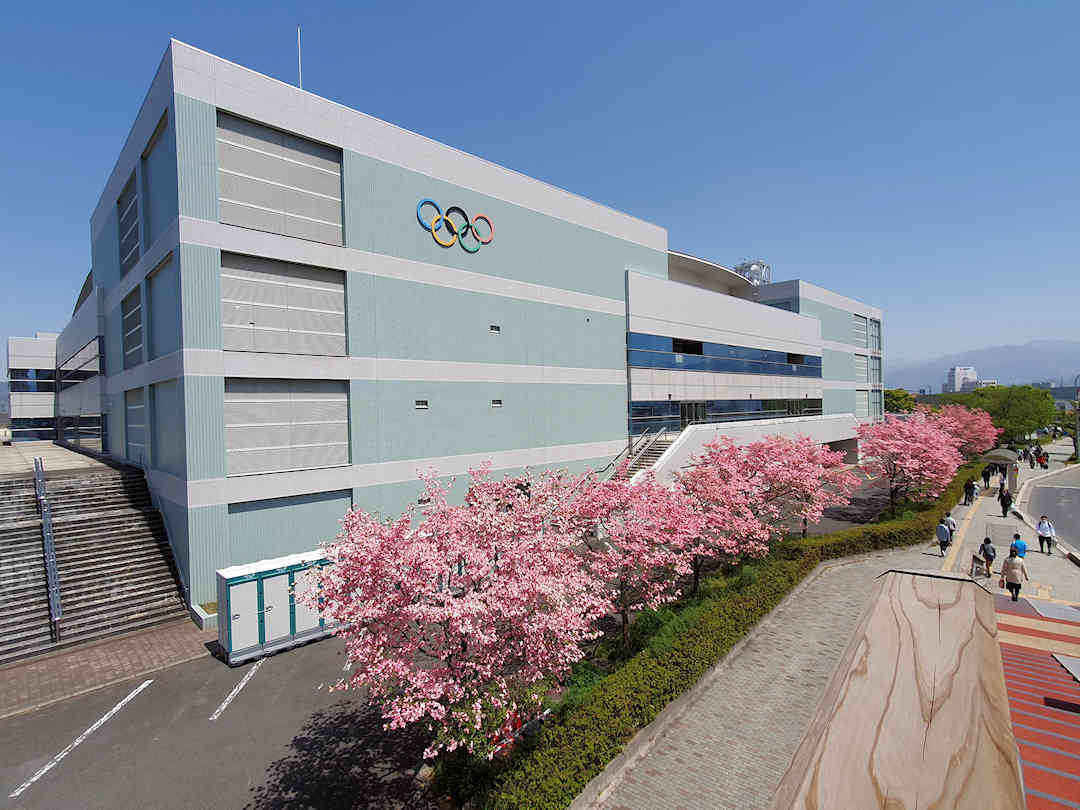
Held in the second half of April, there is a high chance to experience cherry blossom season during the Nagano Marathon
How many (foreign) athletes attend the Nagano Marathon each year?
While there is a cap of 10,000 participants, only 9,083 started in 2023, and 7,942 finished. It is relatively easy for foreign athletes to attend (more on that below), but only 169 registered and 138 picked up their race numbers in 2023. Check out the complete statistics here.
It is worth noting that the 2026 Nagano Marathon has a strict five-hour time limit. Participants who don’t reach certain checkpoints on the course by a specific time are deemed unlikely to finish the race within five hours. Those participants will be collected when the cut-off times are reached and taken to the finish area by bus.
This happened to one of the athletes who stayed at the same accommodation as us. She had travelled from Singapore to run her first-ever marathon, utterly unaware of the cut-off. And due to language barriers, she didn’t even understand what was going on when she was suddenly directed to a waiting bus.
Do you love to run while exploring new destinations?
Packing the right running gear is crucial to maintaining your routine on business or leisure trips. As a seasoned runner, I always seek the best minimalist gear to make travel runs seamless and enjoyable. Do you have any recommendations or tips for the ultimate packing list? Share your insights and help fellow runners optimise their travel kits.
When and how do you enter the Nagano Marathon (and how much is the entry fee)?
Athletes can register for the Nagano Marathon (only) during a specific period, and only via the official website. Registration for the 2026 event opened at 10:00 on 19 October 2025 and will remain open until 23:59 on 1 December 2025, or until the capacity of 10,000 is reached.
The foreign runner entry fee for the 28th Nagano Marathon is JPY14,300. The entry fee must be paid by 1 December 2025, at the latest. Payments can be made with Visa, Mastercard, JCB, American Express, or Diners Club credit cards.
Upon entry, each athlete is required to provide their estimated finish time, as the race number and start area are based on this time. For example, an estimated finish time of 3 hours and 15 minutes will give you a race number starting with 2000 and place you in start area D.
It is also important to note that, unlike other marathons, no costumes or disguises are allowed. That said, on race day, several participants wore funny hats, wigs, or lightweight costumes that didn’t interfere with their running or with other participants.
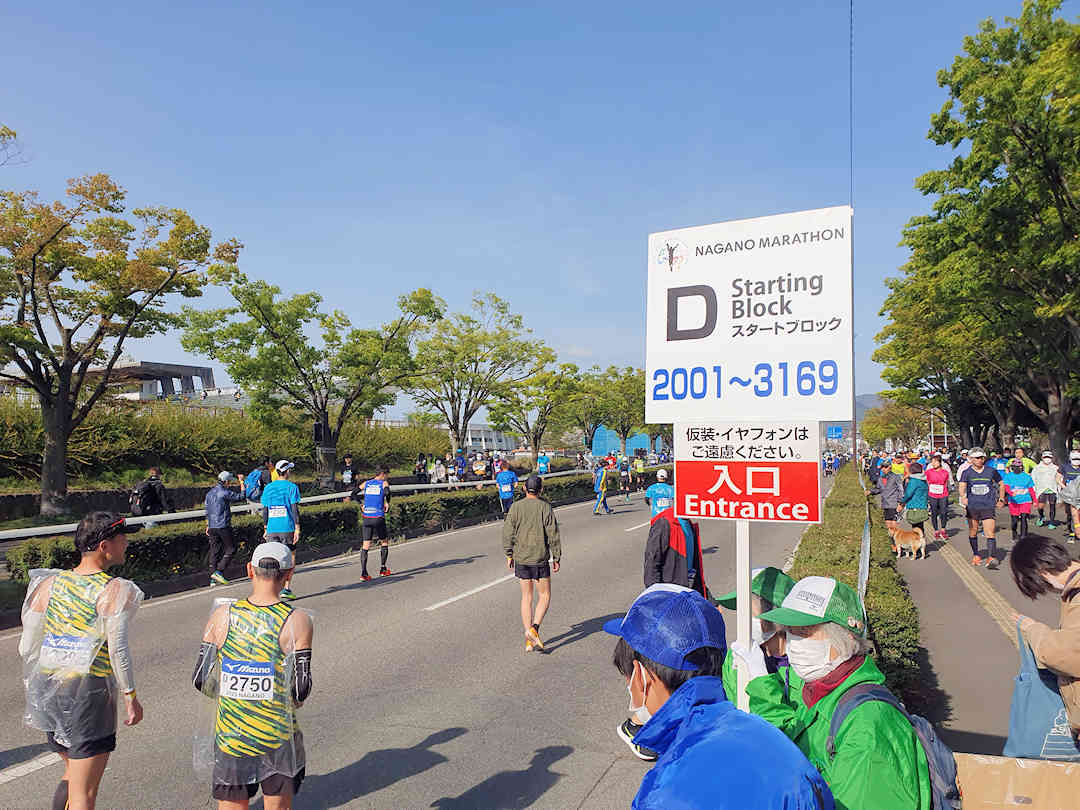
Your estimated finish time determines your race number and start area for the Nagano Marathon
Keen to run a marathon in Africa?
Are you keen to run a marathon in Africa? Are you considering the Marrakesh Marathon but don't know what to expect? Check out my detailed review and all the information you need to attend the event in 2026.
Where can you pick up your race pack, and what can you expect?
In prior years, athletes would pick up their race packs from the Nagano Wakasato Tamokuteki Sports Arena / Big Hat [Google Maps location] on the day before the marathon. Things will be a little different in 2026:
- Athletes based in Japan will receive their race pack by mail.
- Foreign athletes still need to pick up their race pack before the marathon on either Saturday, 18 April, or Sunday, 19 April 2026. The location of the pick-up and opening hours will be announced by the end of March at the latest (on race day, pick-up will be near the start line).
I also presume that this change means there will be no Sports Expo in 2026. Not a huge miss, but still, I always enjoy the Sports Expos, even if I seldom buy anything.
The 2023 race pack consisted of a printed t-shirt, two race numbers (front and back), an official program booklet (in Japanese), a participant’s guide (in English), and an A4-sized calendar featuring images from the previous year’s marathon for each month.

The Nagano Marathon has a Sports Expo with stalls and photo opportunities like this
What do Nagano Marathon finishers receive?
In prior years, all finishers received a medal and a commemorative towel, and it seems that this will still be the case in 2026. There are also awards for those placed first to sixth in each age group.
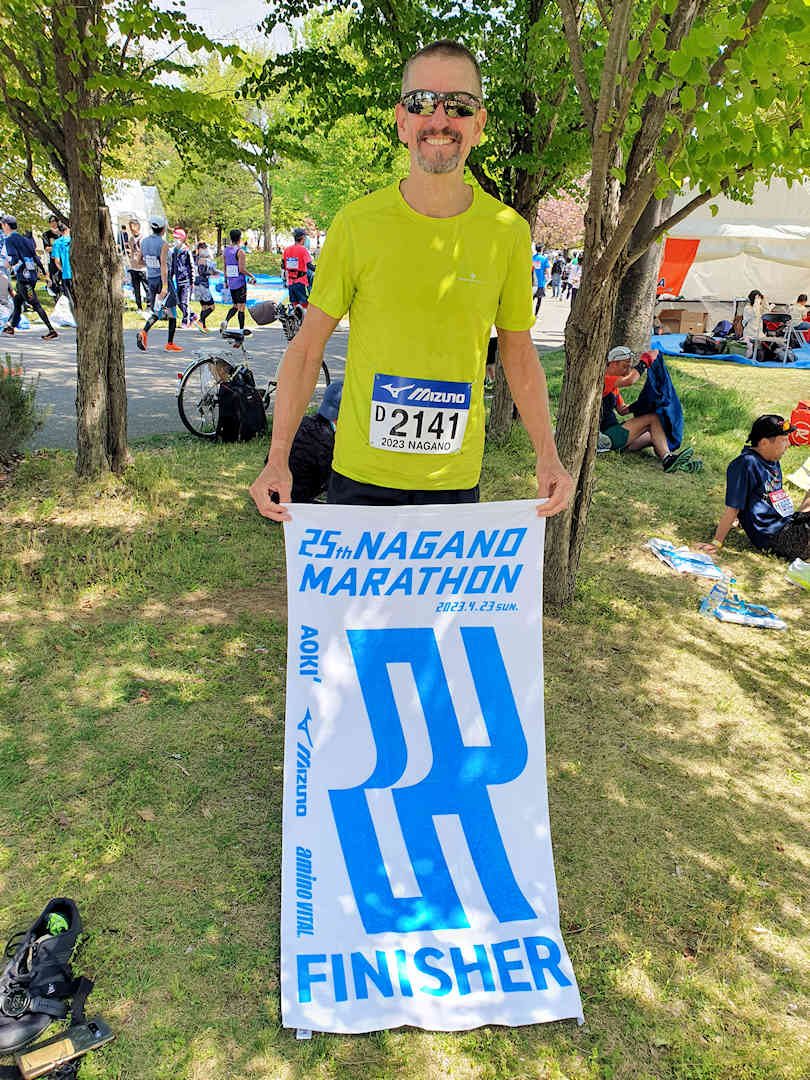
In 2023, all finishers received a medal and a commemorative towel
When and where are the Nagano Marathon race results published?
Compared to other marathons, the race data management at the 2023 Nagano Marathon felt incredibly archaic (it was the same in 2024 and doesn’t seem to be much better in 2025):
- No live results data was published during the race. And at the end of race day, only gross finish results were provided to each participant individually (as a PDF file) – data that any athlete running with a sports watch would have anyway.
- Race result summaries of the top finishers were eventually published on RunNet, the largest running portal in Japan, and the World Athletics website. However, at no point did the race management publish the results of all athletes online, a common feature in other marathons.
- Athletes were able to download their certificates with official net times, event photos, and a list of the net times of all finishers just five days after the event. Interestingly, even non-finishers received a certificate showing their 5km times.
On a positive note, the 2023 men’s race was broadcast live on YouTube. (At 37m13s, you can see Sandra on the right, filming in her orange jacket.) The same was the case in 2024. Both race recordings are still available online.
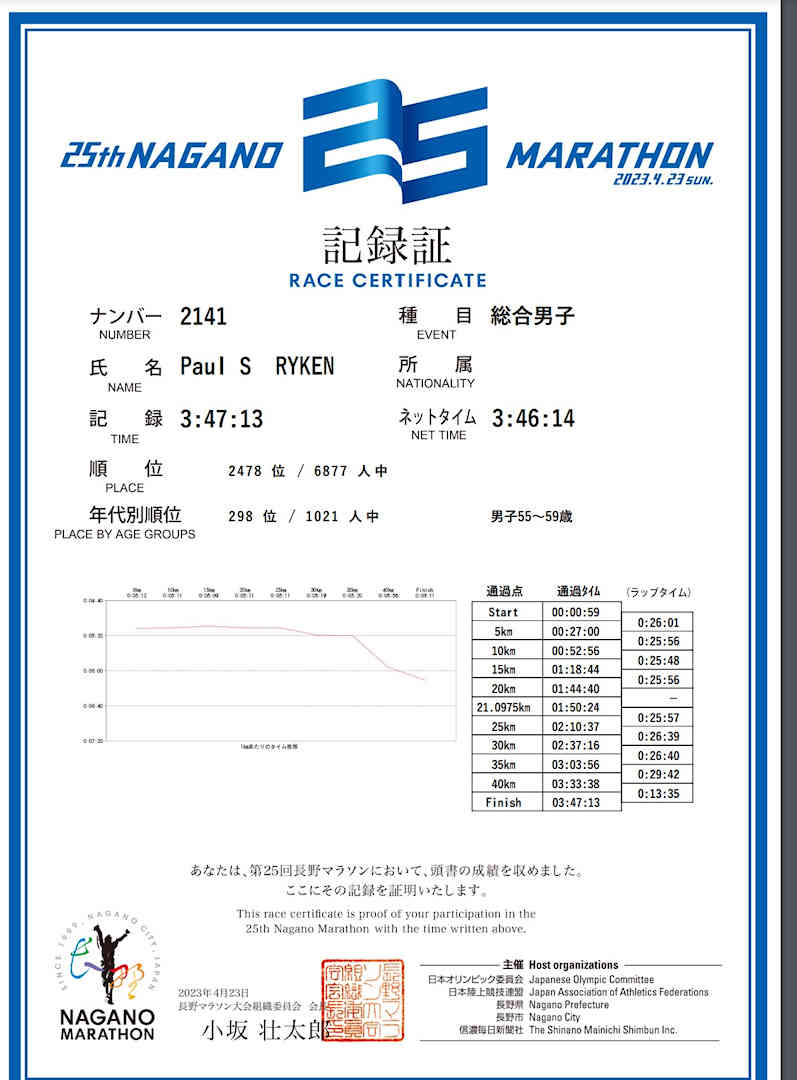
In 2023, athletes were able to download their official race certificates five days after the event
Everything you need to know about the Nagano Marathon Course
Nagano Marathon Route Map with Transport Hubs and Points of Interest
Below is the map of the route, points of interest, transport hubs and recommended accommodations mentioned in this article.
Nagano Marathon Key Locations
The course of the Nagano Marathon is one of the nicest we’ve experienced to date. It leads athletes past key venues of the 1998 Winter Olympics as well as major historic sights of the city of Nagano:
| Point of Interest | Course location | Description |
|---|---|---|
| Nagano Sports Park | Start | Key venue for 1998 Olympic Games ice hockey events |
| Zenkō-ji Temple | 6km | Founded in 642, Zenko-ji Temple is one of the first Buddhist temples in Japan and a key pilgrimage sight |
| Big Hat | 10km | Main venue for 1998 Olympic Games ice hockey events and venue for the Nagano Marathon race pack collection and sports expo |
| M-Wave (see note on minor course change in 2025 above) | 17km | Speed Skating venue during the 1998 Olympic Games and current location of the Olympic Museum |
| White Ring Arena | 23km | 1998 Olympic Games figure skating and short track speed skating venue |
| Nagano Olympic Stadium (also known as Minami Nagano Sports Park) | Finish | Venue for the opening and closing ceremonies of the 1998 Olympic Games |

The Nagano Marathon finishes inside the Olympic Stadium, the venue for the opening and closing ceremonies of the 1998 Winter Olympics
Nagano Marathon Course Description
The Nagano Marathon has a point-to-point course, with a distance of about 10 kilometres between the start and finish (as the crow flies). With an elevation gain/loss of 133 metres (caused by a few road bridges and river banks), the Nagano Marathon must be one of the world’s flattest marathons. There are a few out-and-back sections, but those are relatively short. And with the ever-changing scenery and great spectator support, including musical entertainment like drums and alphorns, the course is never dull.
The course is fully closed to traffic, and a large part is smooth asphalt. From 32km to 39km, athletes primarily run on riverbanks, which still have a sealed surface but are narrower and more exposed. Nagano is located in a long river valley surrounded by mountains, and therefore, it is almost always (a bit) windy. As runners approach the Olympic Stadium, the route changes to loose gravel for the final 400 metres, before athletes enter the stadium and run on grass for the final 195 metres until the finish line.

The Nagano Marathon course is stunning and spectator support amazing. There is even an Alphorn orchestra providing entertainment.
What is supplied on the course?
Route/distance marking and timing equipment
The marathon course is very well marked, with distance markers at every kilometre. Timing mats are located every 5 kilometres, as well as at the start, halfway mark, and finish (a total of 4). Each 5-kilometre timing point also had a large Seiko clock. The timing transponder is attached to the race number and is removed by volunteers after the finish.
Pace guides
To help runners achieve specific time goals, the race was supported by ten pacers who ran the course with goal times of 2h50m, 3h00m, 3h15m, 3h30m, 3h45m, 4h00m, 4h15m, 4h30m, 4h45m, 5h00m. The pace guides were all seasoned athletes in their own right.
Support Stations
The fifteen aid stations along the route were well placed apart. The sports drinks were always first, and the water was always last. The following food and snacks are available:
- Energy Jelly
- Bananas
- Sports Yokan
- Chestnut steamed buns
- Salt candy
- Castella
- Sports Caramel
- Rice balls
were provided from the 19-kilometre aid station onwards. The aid station signage was in English.
At checkpoints along the route, cooling spray was also provided— a unique feature we hadn’t encountered at previous marathons.
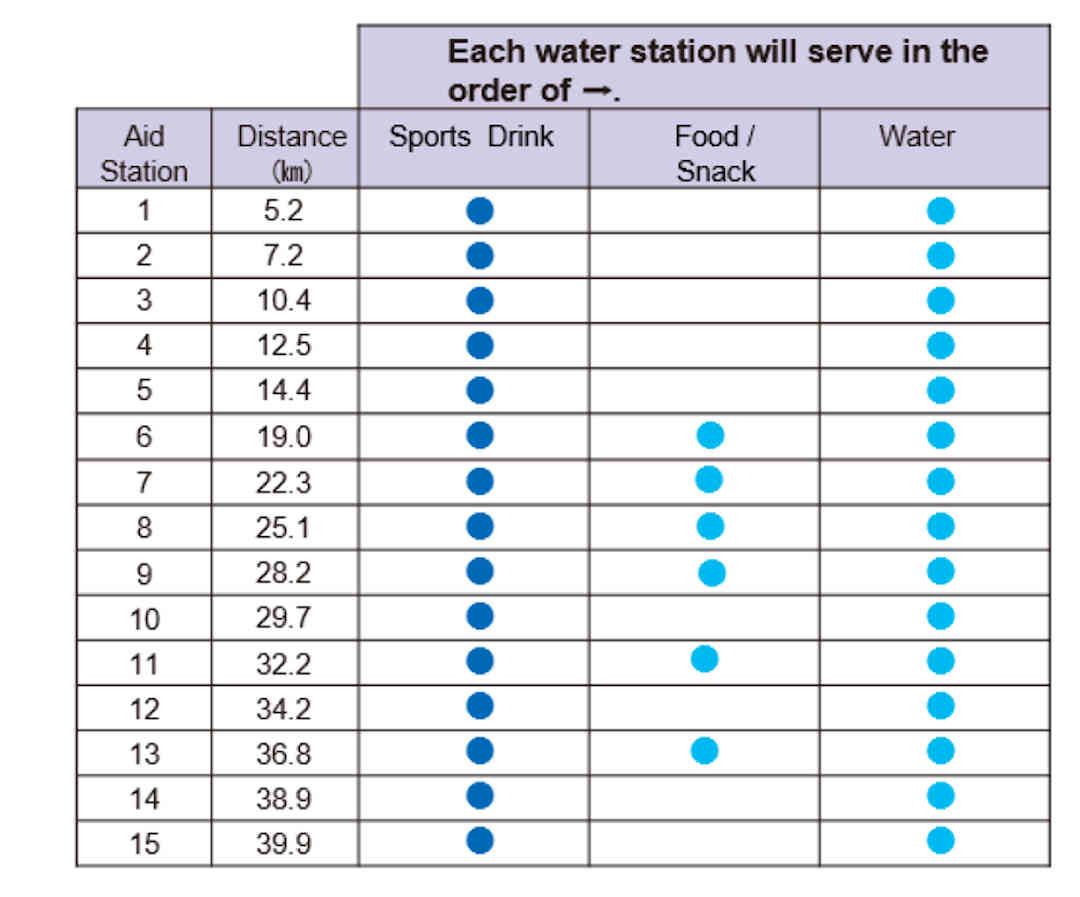
There are fifteen aid stations along the Nagano Marathon course, all well placed apart | Photo by All Sports Community
What is it like to run the Nagano Marathon?
What is it like to run the Nagano Marathon?
Overall
-
Course Difficulty (1 = Difficult, 5 = Easy)
(4.9)
-
Course Scenery
(5)
-
Organisation
(4)
-
Spectators
(4.8)
-
Timing Points
(4.9)
-
Support Stations
(4.9)
-
Value for Money
(4.8)
My personal race experience
Race preparation
Getting injured in mid-December, just weeks after entering the Nagano Marathon, I hadn’t fully recovered until mid-February and thus, my build-up was suboptimal. I averaged only 42 kilometres per week in the 10 weeks leading up to the marathon and only managed to do two 30-kilometre training runs during that time.
I did hike the Kumano Kodo and the Nakasendo in the weeks leading up to the event, which definitely helped my strength and endurance.
Start
After entering the marathon with a 3 hours 15-minute expectation and catering for my lack of preparation, I adjusted my goal time down to 3 hours and 45 minutes (5 minutes 21 seconds per kilometre pace), setting my Garmin Connect workout for the marathon to alert me if my pace was faster than 5 minutes 10 seconds per kilometre. What I couldn’t change however was my start area.
Running the first 5 kilometres in 26 minutes and 1 second (5 minutes 12 seconds per kilometre pace), the route was crowded, and it felt like everyone was passing me. We reached the highest point of the course (383 metres above sea level) soon afterwards, at 6.5km. With a straight downhill from Zenkō-ji Temple, the number of spectators grew considerably, and I ran my fastest kilometre (4 minutes 59 seconds).
Sandra had planned to see me at the 7-kilometre mark, and I was excited to see her. As the Strava Beacon tracker was late, she hadn’t expected me (yet) and scrambled to take a photo as I suddenly appeared in front of her.
10 Kilometres
I reached the 10 kilometres in 51 minutes 57 seconds (at a steady 5 minutes 12 seconds per kilometre pace). Still faster than what I wanted, but I was struggling to go much slower. I knew that would come eventually.
I was taking water at every aid station – something I don’t do on my regular training runs. It was good, and it helped me feel relaxed and in control.
At 15 kilometres (1h17m45s – 5m11s/km pace), I saw giant caterpillars trying to cross the road hoping that they wouldn’t get squashed under all the runners’ feet. I was enjoying the run and the views of the snow-capped mountains around us. Up ahead was an out-and-back section. It was busy with lots of spectators, some even holding signs and cheering in English.
The 20km mark (1h43m41s – 5m10s/km pace) was by a long bridge. There were no spectators on the bridge – except Sandra. She was easy to spot in her orange-coloured jacket.
Half Marathon
At the half-marathon point, I decided to stop – for a photo (which I don’t do normally, but after all, I was running a marathon in Japan). My finish time was important but not that important.
I got to 25km – just past another out-and-back section – in a net time of 2h09m38s (5m11s/km pace). The support stations now offered bananas, so I took a piece at every station all the way to the finish. Digesting bananas during a marathon is easy (and I know them, unlike the artificial sports nutrition that was also handed out).
The 30km had been my longest training run, but when I got there on race day (2h36m17s – 5m13s/km pace), I didn’t have the same aches and pains I’d had in training. It just goes to show: marathon adrenaline helps a lot. Or maybe the two Ibuprofen tablets I took at the 20km mark had worked their magic. Either way, my hips and groin weren’t hurting. But my toes and Morton’s Neuroma were starting to impact me (again).
While there were a few undulations over the final 12 kilometres (in the form of bridge crossings and river banks), the views took my mind off my pain. By now, there were a few people walking, and I felt as though I was passing as many people as were passing me earlier in the race.
30 kilometres
From 30 to 35km, I could feel a nice tailwind gently pushing me along, but I also knew we would be turning back into the wind at 35km. I tried to take advantage of it and kept my pace steady, reaching the 35km mark and the headwind at 3h02m57s (5m14s/km pace).
The bear was on my back for the next 4 kilometres. My toes hurt – a lot. I wondered how many would become black. I tried to stay focused, but I also knew with every kilometre that I was slowing. Eventually, the 3h45m pace group flew past me as if I was standing still. With positive self-talk and meditation, thinking of those who wish they could but can’t, I fought the pain and slowly counted down the kilometres to the finish line.
I knew I could break 4 hours, even if I walked. But I also knew the faster I got to the finish line, the sooner I could stop. 40km (at 3h32m39s – 5m19s/km pace) didn’t come soon enough. At that point, I had walked between a couple of lamp posts. But walking didn’t change the level of pain, so I reasoned (with myself) to just continue running to the finish line.
As I turned from the road onto the gravel path leading to the Stadium, the balls of my feet were screaming at me. At least, I was now less than 800 metres from the finish. On through the tunnel (wondering what it would have been like to win the Olympic Marathon), we finally reached the grassy area inside the Stadium – what a relief. The finish was 200 metres away, and I slowed right down to take in the spectacle and savour the moment. My net finish time was 3h46m14s (5m22skm average pace). I was happy.
After the finish line
Ten metres after the finish, I looked up and spotted Sandra waving excitedly in the Grandstand. A brief hand signal and smile signalled I had seen her and would meet her at the exit.
The finish area was big enough to have a few photos taken of me by a volunteer. Next, I received my medal, finisher’s towel and a disposable mask. As I left the stadium (through yet another tunnel), a sports drink was thrust into my hand. I was pretty thirsty by that time as the temperature had risen sharply, but a sports drink would have been my end. Where was the water? Fortunately, Sandra met me on the other side of the tunnel, and she had our water bottle.
She led me to a shady area near the exit where I laid on the grass for a while, resting and drinking water. Once I felt strong enough, we slowly walked to the departure point for the shuttle buses (about 100 metres away). Very un-Japanese, the volunteer at the bus stop barked at me as soon as I arrived, as I didn’t have my shuttle voucher ready to hand it to him. After I managed to find the voucher and hand it to him with shaky hands, I was finally allowed on the bus. I even found a seat.
Sandra took off on her bike, and once our bus was full, it left for Shinonoi Station. From there, I had to (pay to) take the (by then packed) train to Nagano Station, which (due to delays on the line) meant I ended up standing for more than 40 minutes – not much fun after running a marathon. In hindsight, I should have (not listened to the advice in the participant’s guide and) taken the other shuttle bus option straight to Nagano Station.
Pros
- Entry fee good value for money
- Separate race pack pick-up area for foreign entrants
- Ideal weather conditions
- Good spectator support around the course
- Kilometre markers were prominent
- Good supply of food at aid stations
- No sponges at aid stations.
Cons
- Lack of accommodation (and significantly increased accommodation rates)
- Caters primarily to Japanese runners (for example event program was only supplied in Japanese)
- Event t-shirts were not high-quality
- The start area is a little chaotic
- Impossible for spectators to follow runners at regular intervals on public transport
- Archaic timing data communication
- Sports drinks at aid stations are very strong
- No water was provided at the finish line.
How to get to Nagano?
By Train
Nagano is located northwest of Tokyo and can be reached from there (on the Hokuriku Shinkansen) in just under 1 hour and 30 minutes. From Nagoya, the Shinano Limited Express (the same one you might take if you hike the Nakasendo Trail) will take 3 hours to Nagano.
If you’re coming from Kyoto/Osaka (or even further west), you can travel
- via Tokyo
- via Nagoya
- via Kanazawa (using the Thunderbird and Hokuriku Shinkansen).
All options take approximately 4 hours and 15 minutes to 4 hours and 30 minutes, though, for those without a JR Pass, the route via Tokyo is the most expensive.
By Plane
The closest airport to Nagano is Shinshu-Matsumoto (IATA Code: MMJ), located near the town of Matsumoto. It offers regular regional services (except during winter) from Sapporo, Fukuoka, Osaka, and Kobe.
From there, it takes 2 – 2.5 hours by bus and train to Nagano city centre.

Nagano doesn't have an aiport but being located on multiple shinkansen lines, train travel to Nagano is easy and convenient
Where to stay during the Nagano Marathon?
Accommodation in and around Nagano during the marathon weekend book out many months in advance – even before the marathon date is officially announced – and prices multiply for the one night before the marathon. If you have the luxury of choice, we recommend booking accommodation near Nagano Station – which has good public transport connections to the start and finish (more on that below).
While we booked our accommodation in Japan (including in Nagano) through familiar booking websites such as Agoda, Booking.com and Rakuten Travel, the Japan Tourist Bureau (JTB) is the official accommodation coordinator for (foreign) entrants. However, all options provided through JTB were (way) out of our budget.
There are very few hotels near the Nagano Marathon start line or finish line. Below are our recommendations for hotels near Nagano Station in the city centre (which are still bookable at the time of this update). See below for how to get to the start line and travel from the finish line. I recommend you take the official shuttle bus back to the Nagano Station after the race.
| Name | Property Features | Type | Price Indicator | Book Now |
|---|---|---|---|---|
| Sotetsu Fresa Inn Nagano | 50 metres from Nagano Station | Hotel | $$$ | Book Now |
| Backpackers Dorms Miwa (on Nagano Marathon weekend) | 50 metres from Hongō Station | Hostel | $$$ | Book Now |
| Hotel Livemax Premium Nagano Ekimae | Hotel | $$$ | Book Now | |
| Hotel Metropolitan Nagano | 150 metres from Nagano Station | Hotel | $$$ | Book Now |
| Compass Nagano | 450 metres from Nagano Station | Hotel | $$$ | Book Now |
| The Saihokukan Hotel | 1200 metres from Nagano Station | Hotel | $$$ | Book Now |
| Dormy Inn Nagano | 250 metres from Nagano Station | Hotel | $$$ | Book Now |
| Jizokan Matsuya Ryokan | Ryokan | $$$ | Book Now | |
| Nagano Tokyu REI Hotel | 150 metres from Nagano Station | Hotel | $$$ | Book Now |
| Hotel NewNagano NeXT | 250 metres from Nagano Station | Hotel | $$$ | Book Now |
| Hotel Courtland | 150 metres from Nagano Station | Hotel | $$$ | Book Now |
| Mash Cafe and Bed | 200 metres from Nagano Station | Hotel | $$ | Book Now |
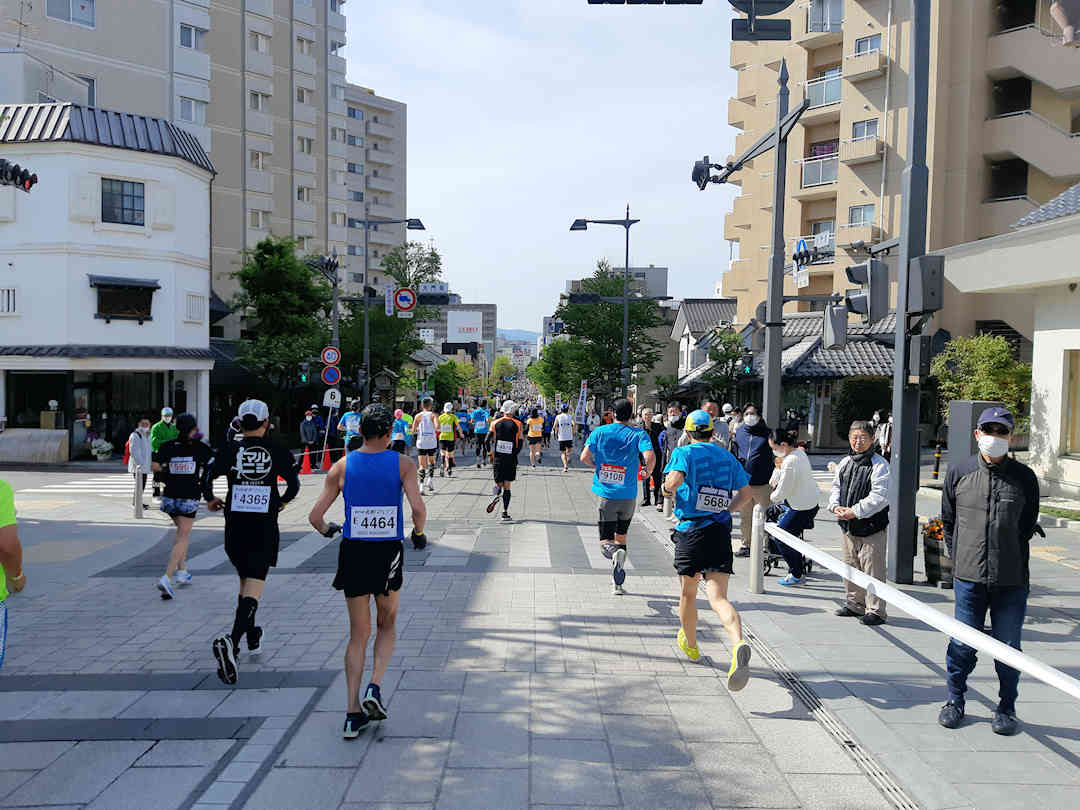
Accommodation in and around Nagano during the Marathon weekend book out many months in advance | Photo by Michael Glenny
What we did
We arrived in Nagano on the Monday before the marathon. We stayed at the Sotetsu Fresa Inn (a block away from Nagano Train Station) for the first five nights, at the very affordable rate of JPY6,250 per night for a small double room. The hotel would have been a great choice for the marathon – albeit a twin room would have been more comfortable (the double bed was only 120cm wide).
When we booked, however, the Sotetsu Fresa Inn in Nagano was already booked out on the night before the marathon. The only other (non-smoking) room we could find at the time was in Ueda, a small town south of Nagano (and only a 12-minute ride on the Hokuriku Shinkansen from Nagano Station). Two weeks before the marathon (we kept looking daily in case rooms were cancelled), Backpackers Dorms Miwa (a hostel near the start line) suddenly offered rooms on Booking.com, and we managed to secure a twin room with a private bathroom and a shared kitchen/lounge (cancelling our original booking in Ueda).
The room cost JPY10,530 per night and turned out to be a great choice. While basic (as to be expected with a hostel), it was clean and quiet, and the host was super nice, providing food and drinks on the marathon morning and even driving the three runners staying at his hostel to the start line.

After initially booking accommodation outside of town, we found a room near the start line only two weeks before the race | Photo by All Sports Community
How to get to the start line/travel from the finish line?
To the start line
The Nagano Marathon starts at Nagano Sports Park [Google Maps location]. The closest train stations are Kita-Nagano [Google Maps location] (on the Shinano line, covered by the JR Pass) and Asahi [Google Maps location] (on the Nagano-Dentetsu line, not covered by the JR Pass). From either of those stations, it’s a flat 15 to 20-minute walk to the start line.
At Nagano Sports Park, you’ll find the usual start line facilities, including trucks to drop off your gear and plenty of toilets, including porta potties. Signage (at least in 2023) was only in Japanese. Use Google Translate on your smartphone if needed. That said, the starting areas had Roman letter signs (A, B, C, etc).
From the finish line
In 2023, the event organisers provided free shuttle buses for athletes from the finish line to either Nagano JR Station [Google Maps location] or Shinonoi JR Station [Google Maps location]. The advice was for athletes to use the buses to Shinonoi over those to Nagano as the latter might be stuck in traffic for some time.
I followed the advice and took the shuttle bus to Shinonoi. Not only did I have to pay for the train ride from there to Nagano Station. I also had to wait (standing) for 45 minutes until a train arrived (and then another 15 minutes on the train, standing squeezed between other passengers). This is not something you want to go through after running a marathon. Based on that experience, we recommend taking the shuttle bus to Nagano Station.

This map at the finish area shows the departure points of the different shuttle buses
Xero Shoes HFS II Review: The best minimalist running shoe yet?
Wondering what the Xero Shoes HFS II are like? In this in-depth review, I’ll explore the shoe’s pros and cons and compare it to the original HFS.
How to go about supporting a participant?
Due to the course layout and lack of public transportation options on Sundays, it is impossible to follow and cheer on a participant using public transport. The organisers provide a paid bus shuttle for spectators to the Olympic Stadium from Nagano JR Station (JPY 600) and Shinonoi JR Station (JPY 250), so that spectators can at least cheer their athlete (s) across the finish line.
What we did
As Sandra wanted to support me as often as possible along the course and still be at the finish before I arrived, she opted to rent a bicycle. The lovely older couple running Miyamoto Shōkai [Google Maps location] (near Nagano JR Station) rented one to her for JPY1,500 for the day (their son also ran in the race). She didn’t go to the start line (as I had received a lift from our accommodation host) but managed to cheer me on at the 7-kilometre mark, at 20 kilometres, at 34 kilometres, and at the finish, cycling about 35 kilometres that day.
Since we both had Japanese (data-only) SIM cards, Sandra tracked me using the Strava Beacon feature, although the tracker was always a bit delayed. As Strava Beacon requires cellular data, I carried my Smartphone (as I usually do for every run) in my Original SPIbelt.
While she had made a rough plan for how she might support me, being able to virtually follow me during the race allowed her to make adjustments as needed. Unexpected road closures and spectator crowds blocking footpaths meant that she had to deviate from her intended route a few times. After the race, she cycled back to return the bike to Miyamoto Shōkai, while I caught the free shuttle bus to Shinonoi Station and then took the paid train back to Nagano JR Station to meet her.

Due to a lack of public transport options on Sundays, Sandra hired a bicycle to support Paul during the Nagano Marathon
What to do in/around Nagano besides the marathon?
Nagano Prefecture is not all about the marathon, so ensure you add a few days before/after your marathon.
Here are our favourite day trips from Nagano:
The hiking area is located to the northwest of Nagano and can be reached by bus from Nagano JR Station in a bit over an hour. The Alpico Bus stop for Hakuba (number 26) is opposite the Nagano JR Station, and tickets can be bought at the Alpico office [Google Maps location].

Hiking to the five shrines on the Togakushi trail is both spiritual and cathartic
Below is the map of the various Shines located on Mt. Togakushi.
Obuse is located northeast of Nagano (on the Nagano Dentetsu Line) and can be reached by train from the Nagano Dentetsu Station (just north of the Nagano JR Station) in just over 20 minutes.

Obuse town scene
If you’re after a traditional Japanese spa experience, Nozawa Onsen [Google Maps location] is a spa town north-east of Nagano (about 1.5 hours by train and bus), offering access to a variety of hot springs to day visitors. To get here
- Take the JR Shinano Tetsudo Kita-Shinano Line or Hokuriko Shinkansen from Nagano JR Station to Iiyama JR Station (both are covered by the JR Pass).
- From the bus stop outside the station, take the Nozawa Iiyama Line Bus (野沢飯山線) to Nozawa Onsen.
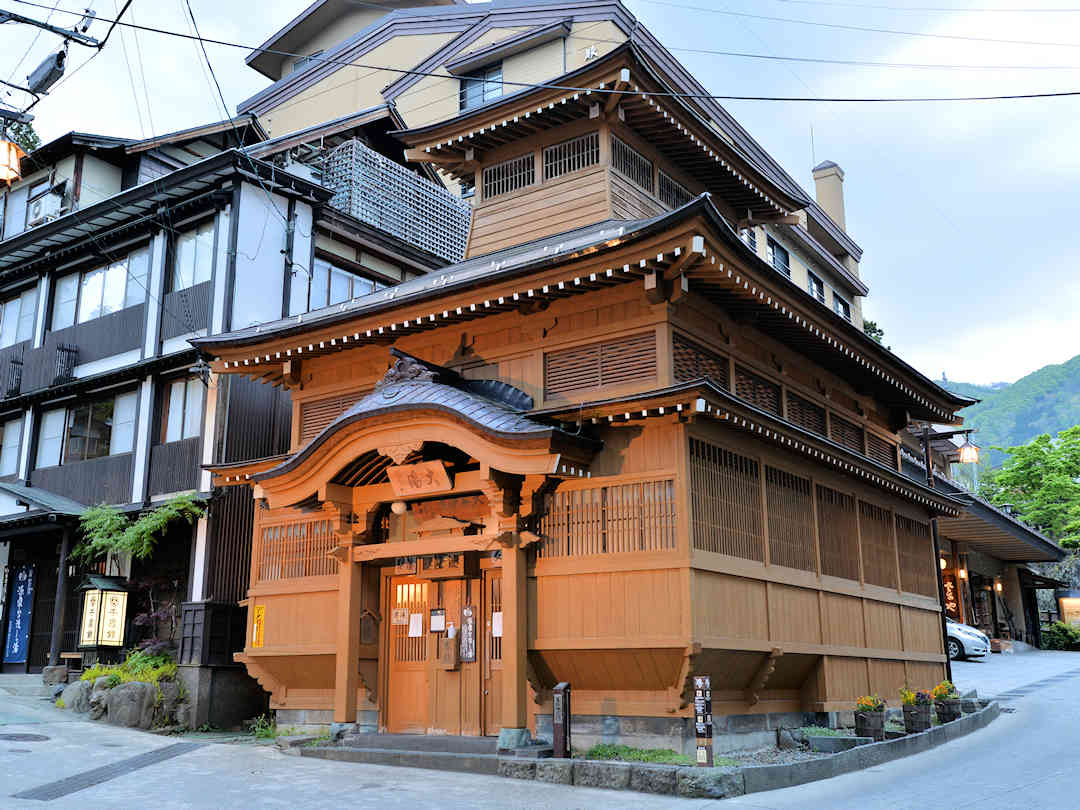
Oyu in Nozawa Onsen
Nagano prefecture is also home to 80 sake breweries and 35 wineries. So why not visit a few wineries or join a sake/miso tour run by a local?
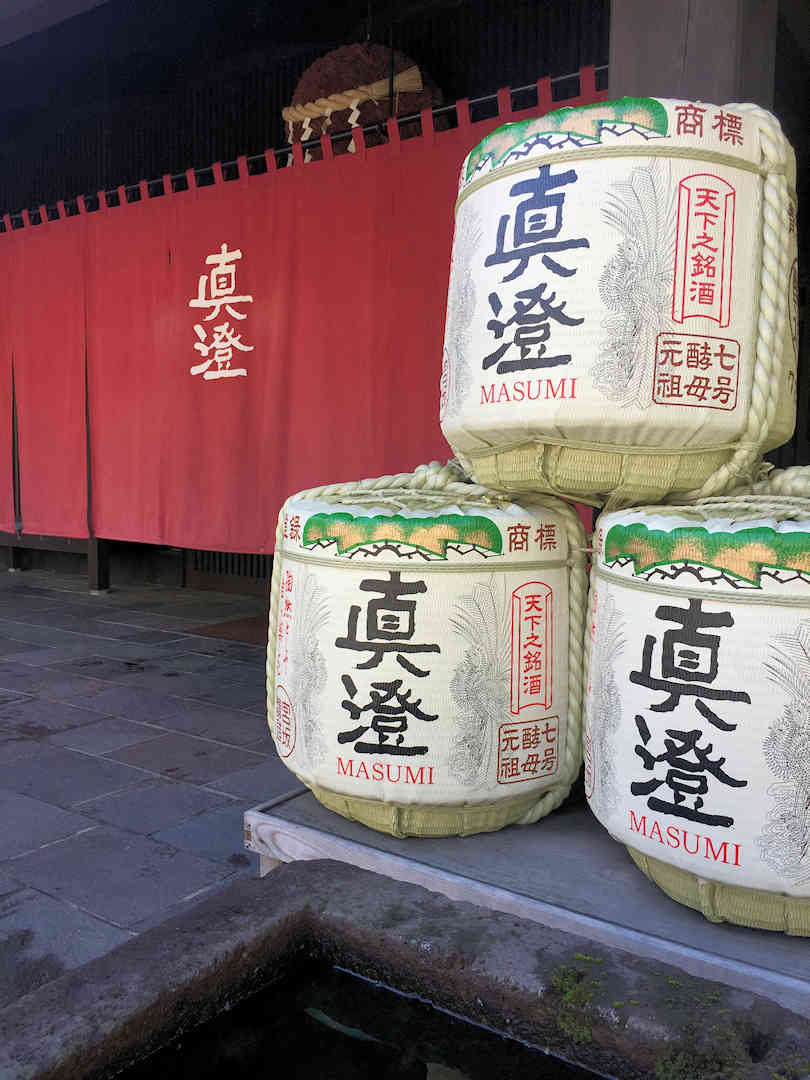
Miyasaka Brewing Co in Masumi
Have you run the Nagano Marathon?
I wrote this race guide and review based on my own experience at the 2023 Nagano Marathon, incorporating feedback from athletes who ran the 2024 event. If you’ve run the Nagano Marathon and have something to add, please feel free to contact me.
Before you go, if you liked our article and found it helpful, we would appreciate it if you could share it with your friends and family via the Share buttons below. Even better: Leave a short review on Trustpilot or Google, which would help us further build our online reputation as a (trustworthy and helpful) travel and lifestyle blog.

